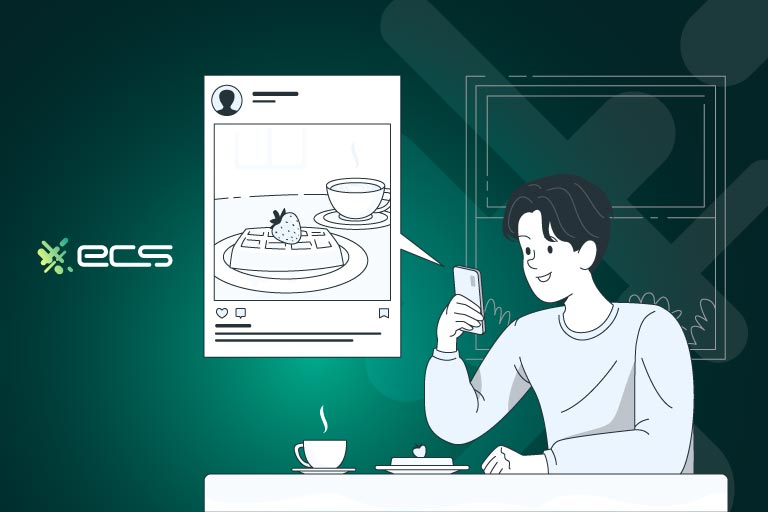We have some specific viral restaurant social media ideas to help you engage more customers and boost the popularity of your brand online and in person for higher sales.
Social media is one of the best platforms for marketing your restaurant because social proof is a driving factor. Social proof is when potential customers see other real consumers engaged with your brand—following your page, liking your posts, and writing comments.
A quick glance at the social media landscape will show you that there are fads and trends. Your business can ride these ever-changing patterns like a surfer on a wave, catching extra attention. There are also “evergreen” restaurant social media ideas that have long-term appeal.
What Are the Most Popular Social Media Platforms?
The most popular social media platforms are Facebook (2.99 billion users), YouTube (2.53 billion), WhatsApp and Instagram (tied at 2 billion each), TikTok (1.08 billion), and Snapchat (750 million). There are dozens (if not hundreds) of others including Twitter, Pinterest, and LinkedIn. But as it turns out, overall popularity might not be the most decisive factor about which platforms your restaurant should use.
Different age groups have different social media preferences. The most used platform among consumers aged 12-34 is Instagram (31%), followed by TikTok (20%), Facebook (20%), and Snapchat (12%).
The story is much different among consumers aged 35-54. These consumers prefer Facebook (55%), followed by Instagram and TikTok (each at 12%), and then Twitter (9%). And as for consumers 55 and up, Facebook dominates, with 74% using it the most often, and all other platforms only reaching a combined 26%.
Part of this disparity has to do with the layout of each platform. Instagram is more visually oriented, while Twitter is focused on written posts. Facebook lends itself well to socializing (checking in on friends and family, seeing what they’re up to, and commenting on it), while TikTok is all about the rapid consumption of short videos.
Restaurant owners also need to consider their audience. Some businesses can effectively ignore consumers under the age of 18, while for others, that is their entire market. Restaurants will run the spectrum of who you are gearing your marketing efforts towards. An upscale restaurant would be wasting its effort marketing to teenagers, while a family-oriented restaurant would find this worthwhile.
Consider which social media platforms your ideal diner is using, and focus your efforts on that platform. However, do not forego using other platforms as well. The average American has 8 different social media accounts. It’s likely that you will at least want to have an online presence on Facebook, Instagram, and TikTok (unless TikTok is illegal in your state).
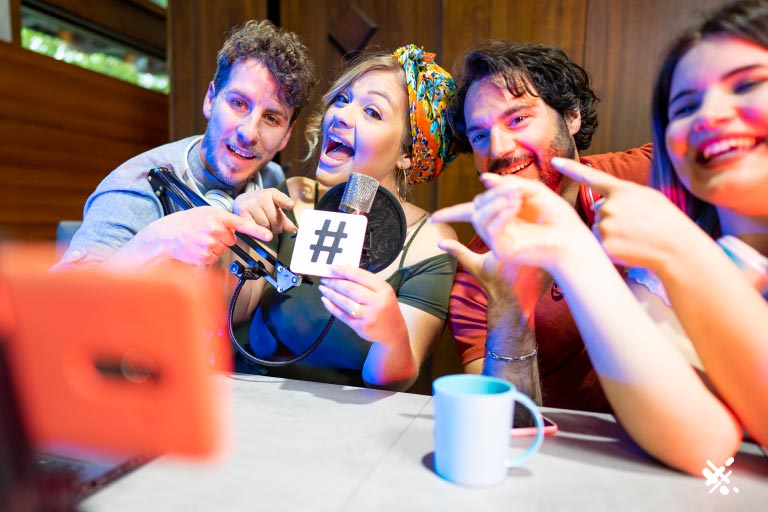
What Are Hashtags?
Before going into specific social media ideas for restaurants, let’s talk about hashtags. A hashtag is that # symbol. But on social media platforms, attaching the # symbol to a word in a post caption drops that post into a bucket with similar types of content. This user-generated filing system allows people to interact with the types of content they are interested in. It also makes it easier for the platform to recommend content that users might like.
Try it out yourself by searching on Instagram, Facebook, and TikTok. Type “restaurant” or “foodie” into the search bar. Look at the posts that come up and see what types of hashtags users are putting in the captions.
It will probably be things like #foodie #foodstagram #foodtok #foodporn #foodaddict #foodlover. Some of the hashtags will focus on niche products (#craftbeer), while others will focus on location (#nyceats).
Study these hashtags, young cricket, and one day you will be a hashtag kung-fu master. Search for hashtags relating to your restaurant, and see what other hashtags similar posts are using. These are hashtags that you should be putting in your post captions. If you don’t do this, fresh faces will not be able to discover your posts or your pages.
What About Paid Ads?
Although trends are helpful for attracting attention, the days of organic growth on social media are probably over. This means that if you really want to have some good reach, you’ll need to put in a little money. Thankfully, “little” is a pretty accurate term because social media ads are very inexpensive.
You can take any post and turn it into an ad just by paying a handful of dollars. Even better, you can select which users will get to see that ad. On Instagram, for instance, you can pick the gender, age, location, and interests of your target audience.
Want consumers aged 18-34 in Philadelphia who like ice cream and desserts to know about your new water ice stand? No problem. Want consumers aged 45-54 in Las Vegas who are interested in pizza or Italian food to know about your brick-oven pizzeria? No problem. Plug in your own example.
You can pick your budget and the number of days you want it to be “boosted.” This is a great way to amplify your posts at a very low cost to a targeted audience of ideal customers.
Cooking Demonstrations
One of the easiest restaurant social media post ideas is a cooking demonstration. Take a look at chef Joe Isidori on Instagram (username @joeisidori), the owner of Arthur & Sons New York Italian (@arthurandsons).
Joe has some great Instagram videos where he cooks up some of his favorite dishes: spicy rigatoni alla vodka, shrimp scampi, and veal chop alla tartufo. Of course, all these dishes are on the menu, so his 39,000 followers know they can pop into the restaurant and taste what he’s cooking.
You do not have to be the one behind the camera unless you’d like. You can ask your chef, line cooks, or other kitchen staff to serve up something they like for the camera. If they have their own social media profiles, they can tag your restaurant in the post. This will give your restaurant some additional word-of-mouth promotion within that staff member’s social circle.
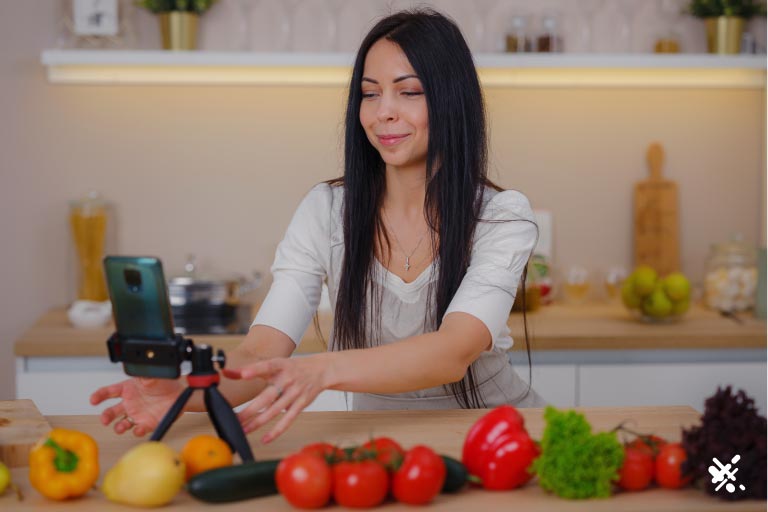
Influencer Partnerships
Social media influencer partnerships are not just a unique idea for restaurants. Many brands are turning to influencer and micro-influencer marketing to boost brand reputation. A social media influencer is someone who is perceived to have credibility within a certain industry or lifestyle.
They aren’t necessarily professionals (although sometimes they are). They just have followers on social media who are interested in what this person has to say or what they do.
Social media influencers post videos of their lives on social media. Usually, the content will circulate around one particular content: food, makeup, travel, personal finances, dance, art, teaching, and carpentry are just a few examples.
Followers appreciate the authenticity, relatability, and trust that they find in influencer content. It’s a candid, real-life offshoot of the reality TV craze that started in the 1990s. Influencers are real people doing real things.
Sometimes, influencers have millions of followers, and sometimes, they are already celebrities in their own right. Celebrity chef Gordon Ramsay (@gordonramsay) has 14 million Instagram followers.
But plenty of other food influencers don’t have their own TV show and aren’t Michelin-Star professionals. Maya Leinenbach (@fitgreenmind) is a young woman preparing vegan recipes with 2.7 million Instagram followers. Cédric Grolet (@cedricgrolet) is a pastry chef who specializes in making baked goods that resemble fruit, with 6.7 million followers.
Wierd Restaurnt Social Media Ideas
Then there are more offbeat pages, like Kim & Liz (@kimlizasmr). This duo of women influencers eats large quantities of sugary snacks and fried foods, with special emphasis on the gustatory noises they make while eating them.
This genre is referred to as ASMR or autonomous sensory meridian response; it describes tingling sensations in response to stimulation like crunching and munching.
Sounds bizarre, but there are entire fanbases that circulate around ASMR content and something similar called mukbang. Mukbang started in South Korea around 2010, and the word literally means “eating show.” Mukbang influencers just sit down and eat food.
That’s all there is to it. Mukbangers like Soo Tang (@mommytang on YouTube) have close to half a million subscribers and may draw in six figures in endorsements and partnerships per year.
If you don’t believe us, do some searching for #asmr and #mukbang on social media channels and see what comes up. These posts might give you some zanier restaurant post ideas that are out of the box. Mukbang and ASMR can be combined with influencer marketing if the star of the show is a social media influencer.
However, you don’t have to get someone like Martha Stewart to sit down and munch on fried chicken or slurp noodles next to a microphone. You can also turn to micro-influencers to push restaurant brand recognition.
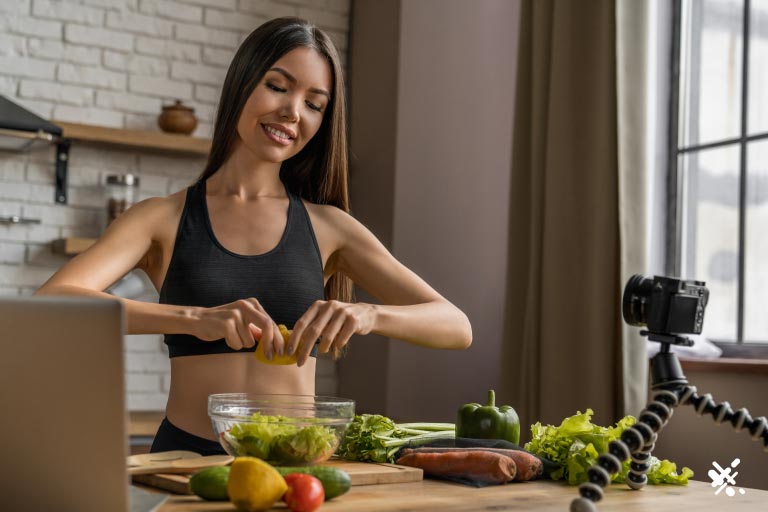
Microinfluencer Marketing
Microinfluencers have just a few thousand or tens of thousands of followers. Their interests circulate around more niche topics. For example, instead of just “food,” they might specialize in “vegan food,” or “mushrooms,” or “kosher food,” or “halal food” or “seafood boil.”
Although microinfluencers are not as popular as mega-influencers, their followers find them even more relatable and trustworthy because they connect on very specific topics.
Microinfluencers are also far more accessible to most small and midsize business owners. You’ll have a much easier time reaching out to a microinfluencer to come on down to your restaurant and film themselves and/or some friends having dinner.
You will want to create some expectations around the content without being too controlling. The influencer will expect dinner on the house, and you’re expecting them to make a permanent video post and put that post in their “stories” for 24 hours (as an example).
Microinfluncer marketing pays off, and engagement rates are better than influencers with a larger following. For instance, microinfluencers on Instagram with under 15,000 followers have a nearly 4% engagement rate, compared to mega-influencers with more than 1 million followers, who have a 1.2% engagement rate.
On TikTok, the disparity is even greater, with microinfluecners (under 15,000 followers) having 18% engagement and mega-influencers (one million followers) having a 5% engagement rate.
Around 82% of polled social media users are likely to actualize recommendations from a microinfluencer. This type of social proof is the most impactful and efficient word-of-mouth marketing you can buy.
And it’s not expensive, either. 96% of microinfluencers charge less than $1,000 for a featured post. Remember, these posts reach thousands or tens of thousands of very engaged followers. And 84% of microinflunecers charge less than $200 per post.
You can find microinfluencers by typing in local hashtags related to food (#phillyeats, #nyceats, #houstoneats, #bmoreeats, for instance). The platform will show you the most popular posts, and you can scroll through them to see your options. If organic research sounds too daunting, there are cloud-based services that will find social media influencers for you.
Have Diners Create Content
Another great pathway for marketing a restaurant on social media is to ask for user-generated content. User-generated content, or UGC, is when social media users post about your restaurant of their own free volition. You are not paying them to do this, but you may need to ask them.
If you’re wondering how to monetarily incentivize user-generated content, you generally don’t need to. In case you haven’t noticed, people love posting pictures about themselves on the internet. And one thing they definitely love posting is pictures of the food they eat.
Although you won’t have to pay diners to post pictures of their food to Instagram, you may find that they do need a little bit of a push. You can do that by having a contest or a raffle. Everyone who posts a picture and uses our hashtag this weekend will be entered in our raffle for a gift card! Post this message on your social media accounts and with signage in your restaurant—on receipts, on the wall, on tablecards…etc.
Encourage diners to post pictures of their food and post them on their social accounts using a branded hashtag. A branded hashtag is not something you need to register, but it is something you can claim that relates just to your business. Coca-Cola has done this with the #shareacoke (Share a Coke) campaign.
Coca-Cola paired this campaign with the release of Coke bottles that had common names on them (Ashley, Rachel, David, Steve). Coke drinkers were encouraged to take pictures of bottles they found with their name on them or the names of friends or family members.
Consumers would post these pictures on social media with the hashtag #shareacoke in the comments. If the name on the Coke bottle was a friend or family member, the person could give them a shoutout (with an @ in the description).
The #shareacoke campaign worked in part because it generated some emotional excitement about the “named” Coca-Cola bottles. And although you may not have the bandwidth to enact the same type of social media inspiration (e.g., personalized products disseminated on an industrial scale), you can also tap into the emotional power of grassroots posting.
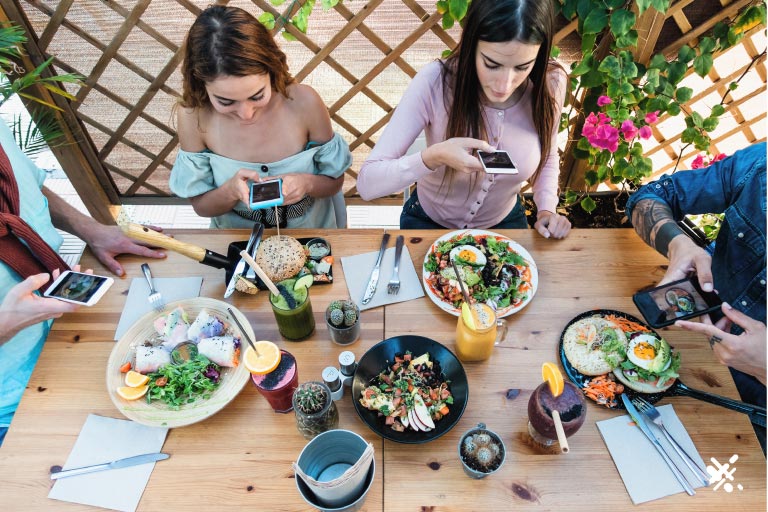
Use Our Branded Hashtag
Ask customers to share their dining experience by posting their pictures on their social media accounts. Post large signage with the social media symbols (the Facebook F, the Instagram camera, the Snapchat ghost). Encourage your loyal customers to use a hashtag that can easily be associated with your restaurant.
You cannot prevent other people from using the hashtag, but if it’s unique enough, the majority of posts it pulls up will only be pictures of your food. The name of your restaurant or its slogan is a good starting point.
You can also encourage your amateur food bloggers (aka your customers) to use slightly more generic, localized hashtags, such as the aforementioned city-eats combo (#sfeats, #tampaeats, #chicagoeats). Pictures of diners in your restaurant will show up when users search these hashtags.
In fact, it’s probably a good idea to encourage diners to use at least two hashtags…one being your branded hashtag and the other something slightly more expansive. #TonysTacoTuesdays and #houstoneats are an example.
User-generated content takes more time and more work, but it’s one of the best ways to build up a social media presence. The branded hashtag creates a sense of community. The pictures begin to build up an authentic brand voice. And the images of menu items are essentially positive reviews from satisfied diners.
The fact is that 85% of social media users will already post about a positive dining experience without being asked. UCG is your chance to leverage this trend into a restaurant marketing plan.
A whopping 93% of consumers incorporate UCG into their decision-making process. That said, a few posts from TacoTuesday might just be the deciding factor about where someone goes to dinner tonight (especially if it’s Tuesday).
Show Some Behind The Scenes Footage
Another great restaurant social media idea is behind-the-scenes footage. Social media posts for restaurants don’t have to just be of food prep or the plated product. There are other parts of your business that will be interesting to your customers.
Do you source any of your ingredients locally? Fish? Eggs? Lettuce? Apples? Take a trip to the farm or out to sea, and bring your phone with you. A short, well-edited minute-long video about fishing for sea bass can become an inviting lead into the catch of the day. A video about apple harvesting can become a compelling advertisement for your fall apple pie dessert offering.
About 87% of polled consumers became more enthusiastic about watching video content if it contained behind-the-scenes footage. Consumers find this type of footage authentic, engaging, and satisfying to their curiosity.
You will want to use discretion when selecting behind-the-scenes footage. A trip to the farmer’s market is visually appealing. A trip to the slaughterhouse is probably not (but never say never).
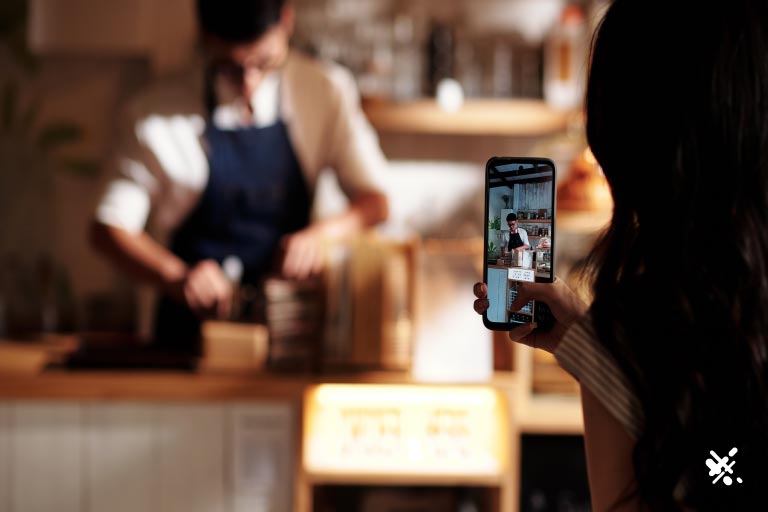
Post Non-Food Content (Memes, Voiceovers)
Social media users often create and amplify trends like dances, lip-synching, and voiceovers from popular movie scenes. You may think this type of fad has nothing to do with social media content for restaurants. And to be fair, on the surface, it does not.
However, a significant number of small businesses are posting more trend-like content, such as movie voiceovers. If you’re on social media, you’ll see users using the same clips applied to different situations in their lives. The end result is often intentionally humorous, highlighting some sort of irony or comic situation.
It takes a little more bit of creativity to turn these snippets into a restaurant social media idea. Here’s an example for Will Ferrel fans: do you recall the scene in Talladega Nights where Ricky Bobby’s wife yells, “I’ve been slaving over this for hours,” and the camera pans over a feast of Pizza Hut and KFC? How about taking that sound clip and playing it over footage of an elaborate spread at your restaurant, like a catered event?
Now that you’ve got the idea, you can think of snippets from your favorite movie. It doesn’t even have to be about food, but food-related movies might yield more ideas: Ratatouille, Eat, Pray, Love, Breakfast at Tiffany’s, and Willy Wonka & The Chocolate Factory are just a few options. You could also use sound clips from popular TV shows to a comedic effect.
Perhaps a few seconds of Gordon Ramsay screaming at contestants while the camera pans over your selection of desserts? Put a little thought into it and have fun. If you’re not savvy with platforms, there is surely someone in your staff (especially under the age of 35) who knows how to put voiceovers into a TikTok post.
Restaurant Social Media Ideas: A Wrap-Up
American consumers spend hours and hours on social media every day. When it comes to making purchasing decisions (such as where to eat out), there is a substantial chance that they will turn to recommendations from their network. There is also a substantial chance they will engage with new businesses that exhibit social proof.
Restaurant social media ideas and marketing strategies are all about creating social proof and positive emotions. Influencer marketing, user-generated content, paid ads, behind-the-scenes footage, and social media user trends (even silly ones) are all great ways to get brand awareness out there.
If some of these strategies seem too complex to implement or beyond your capacity, consider appointing one of your staff members as the social media influencer for your restaurant.
The payoff for social media marketing is not always readily apparent. Business owners are tempted to measure ROI in terms of revenue increase. There are ways to see if social media marketing is effective (such as disseminating a coupon through a social media post). But this kind of thinking misses the forest for the trees.
Social media marketing is all about building long-term brand recognition. It is not necessarily specific marketing campaigns or posts that continue to bring diners through your doors but the positive reputation your restaurant develops online through hundreds and thousands of posts.
